Art, A Social Construct
Abstract
Though art may be an expression of an individual’s internal discourse/dialogue, it is rare that an artist works completely alone. Everything in the artists’ environment affects the artist and thus has an effect on the work. Even the viewer becomes as important as the artist, even more so, at a point. Other artists are simply unable to create without the assistance of others—in everything from the conception to the completion of the project. Historically, artists have taken on apprentices, or interns, to accomplish their own tasks. More and more, collaborative pieces are becoming not only acceptable in the arts, but necessary. This research attempts to highlight the multitude of social influences on artwork, the utilitarianism of collaboration in art, as well as looking at how manipulating materials in every step of the process can influence an artist’s progress.
- Introduction
One of the first interactions between the social world and an artist’s works is the influences that other artists have had on the person. An artist may believe that everything they make comes from solely within themselves, but someone before has made an impression on them and, in turn, their work. Everything around can give inspiration, but there are few advances made by a person who has no knowledge of the previously tested extent of the ability of their materials, or tools. Humans build upon the things that others have done and in doing so, everything progresses exponentially.
The world around is a source of materials, inspiration, and environment available for integration into any artist’s work. Whether a piece is installed in the space the materials were found, or specific elements of the outside are brought in, and everything in between, there is an outside influence on the artist. Through examining both the specific artistic, environmental, and material influences, this introspective research hopes to help myself and others gain a better understanding of the art I have produced and the direction my work will go in the future.
- Artistic Influences
Influence found in other artists is one of the ways artists use to describe their own work. In many artist statements there are references to an artist or artists that inspire them1,2,4. By analyzing another’s work, an artist is able to reflect on their own process and growth. This comparison also gives viewers a place of reference, while highlighting the ways each is unique.
My influences stem from a variety of places. I have been drawn to artists such as Patrick Dougherty, who studied art after years of other pursuits.2 Other than Dougherty and others educated in the arts, I quite enjoy folk art, or works from those who are traditionally, or self, taught, such as Matt Tommey. As I have always admired “outsider art,” any opportunity for those who are not trained specifically to make art intrigues me—Burning Man. One thing that connects all of these influences is their ability to promote incorporating the social world into an individual’s own expression.
2.1. Patrick Dougherty
Patrick Dougherty holds a place of high regard for many artists, critics, and collectors. His large scale works incorporate literal truckloads of tree saplings. The scale of his work has been one of the things to inspire the scale and direction, both with materials and environmental installation, of my own. His ability to amass the help necessary to gather the material and install the works is inspiring. The longevity of his career being over thirty years is partially due to his ability to utilize a team of volunteers in each location—he has now designed and built over 250 of these large sculptures all over the world2. Though these pieces are conceptually Dougherty’s, they would never have become reality without this help from others.
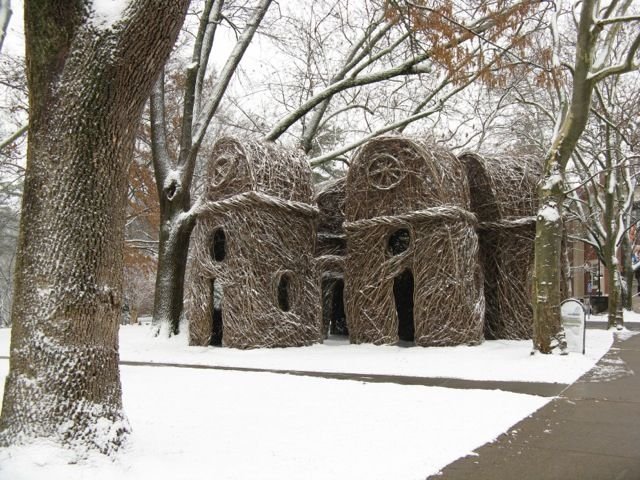
Patrick Dougherty “Old Time Religion” East Tennessee State University 2013-2017 (photo credit Jeff Supplee3)
2.2 Matt Tommey
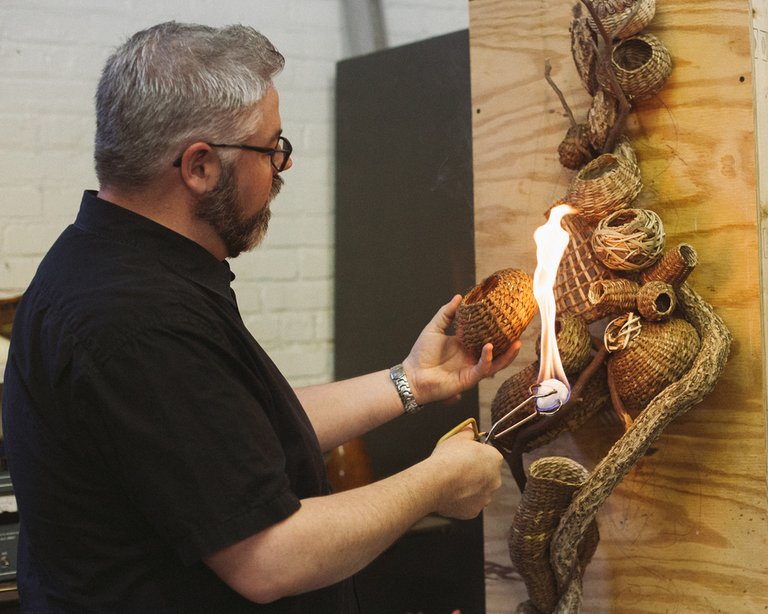
Matt Tommey is an artist based in the River Arts District of Asheville, NC. “Since the mid-1990's Matt's been creating woven sculpture using basketry techniques for his clients that reflect the rustic elegance of nature.”4 He works with locally harvested bark, vines, and branches to create beautiful sculptural basketry. Utilizing natural elements from around the area, traditional and non-traditional basket making techniques, and then finishing the pieces in various borrowed and created encaustic techniques, he has developed his own style. Both in his studio and through YouTube videos5, he teaches others how to harvest, cure, rehydrate, weave, cure, and finish pieces using his techniques.
Tommey makes a business out of doing his art. Though he offers internships, they are unpaid and he requires 15 hours of work a week for a minimum of 3 months.6 Collecting all of the materials he needs to work throughout the year is an enormous task, so he also has employed others to harvest some of his materials, utilizing the community page Craigslist.7 His story emphasizes that in order to produce a quantity of art, an artist needs assistance. I admire him because he does all of this, while recognizing his ability to gift his knowledge to others.
2.3 Burning Man
Perhaps the largest influence on my own journey as an artist has been the Burning Man community. The Black Rock Desert, or “Playa,” and its immense size allow artists to “go bigger,” referring not just to the size of their artistic contributions, but also in the levels of creative expression. Everyone is invited to be a participant, either in bringing their own art or experiencing others’. According to Burning Man Arts, their mission is to “change the paradigm of art from a commodified object to an interactive, participatory, shared experience of creative expression.”9 Participants themselves have expressed that others sharing their art gave them the inspiration to share their own art—which has changed the way they experience art itself;
Volunteer Mary Ellen Burdwood, aka Dirtwitch, recalled that her first Burning Man experience inspired her: “‘I can do art, I can do this, I can share,’ and so we all decided to . . . have a theme camp, create rituals to interact with the rest of the participants. . . I became a Mayan high priestess who sacrificed papayas on the chests of willing and unwilling participants.” Burning Man presented the opportunity to straddle the division between producers and consumers; as another member stated, “it’s a chance for these people to express themselves rather than [be] the audience to stare at something.”10
The art that is shown at Burning Man, or at one of the many regional burns, is different than what one typically sees at a gallery. “It is site specific, temporary, community based and interactive and must also withstand extremes of weather.”11 Another example of what collaboration can make possible—these massive projects that were imagined and created by cooperative teams of participants and brought to these events, primarily for the sole purpose of sharing with others.
- Material Influence and Method
I started utilizing kudzu as a primary material simply because it was there. Gaining access to a bamboo field with 40ft tall stalks gave me opportunity to diversify, within the same context of the availability of natural materials. Originally, I had set out to learn traditional methods of processing the materials. Due to time constraints and the temporary status of most of my art, I have experimented with other methods. Using rope came as a stylistic choice, but thanks to a long history of innovation was available in large quantities.
As difficult as the work is to collect these vines and stalks or tie intricate knots with thousands of feet of rope, I love being able to work with the material from start to finish (i.e. cutting down, processing, building, and/or manipulating the material); however, in the spirit of cooperation, I do not hesitate to request and welcome any and all help, when it is available—one reason I have decided to not make my own rope. Simply by intimately knowing the materials’ entire processes, I feel closer to the end product than I have from any of my previous art.
3.1 Kudzu
The history of kudzu in western North Carolina shows the ability humans have to be an influence on others, even those who are alive generations later. Originally brought to America in the 1880’s, it has long been considered an overwhelmingly invasive plant.5 In utilizing the plant in artistic pursuits, an artist is able to take inspiration from a social influence, however indirect. By Tommey’s gauge, it takes approximately one hour to harvest a roll (1ft tall and 18-24 in diameter) of kudzu appropriate for weaving.7 Just as he employs others to help him collect the vine, I enlist the assistance of my peers and in doing so constantly demonstrate the need for community cooperation in artistic pursuits.
Kudzu preparation is done much like any other vine or bark preparation. Matt Tommey has found the materials are most resilient when harvested while green or slightly before they completely die in the wintertime, then split and dried, before being later rehydrated to work with.12 By weaving the vine while it is still green, some stability of the material is lost. The vines are fragile when they finally dry completely and the weave loses some of its tightness. The curing process takes weeks to months depending on the material. For my work I have eliminated his method of curing and rehydrating processes and woven the kudzu as it is harvested. Though I respect, admire, and know Matt Tommey’s method results in work with more longevity, the scale and impermanence of my work affords me (sometimes requires) the ability to bypass those methods.
3.2 Bamboo
Another plant that is not native to western North Carolina, yet is in abundance, is bamboo. Though growing to heights of over 40 feet and having wood-like properties, bamboo is classified as a type of grass. Bamboo is surprisingly strong, with certain species being nearly as strong as steel. Bamboo is easily susceptible to improper curing. If not cured properly bamboo will be brittle and/or mold. Traditionally bamboo is cured by standing it on end, avoiding contact with soil, for 6 weeks or longer, depending on the thickness of the walls.14 Heat-treating the bamboo stalks maximizes the strength.13
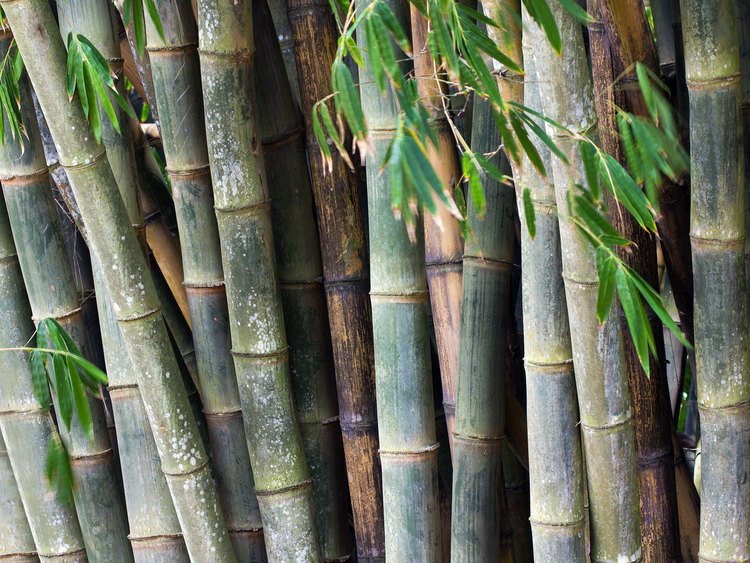
Bamboo species of the genus Dendrocalamus are usually thick-walled, preferring humid mountainous terrain.15 This is most likely the genus I have been harvesting near Asheville, NC.
As drying bamboo poles requires more time than wood of similar density14, I have experimented with other methods of curing the material quicker, with mixed results. Using a steam box to cure bamboo has shortened the length of the process, while allowing the branches of the bamboo to be bent to shape. The bamboo hardens and holds shape, while allowing for some give without breaking. Steaming larger hollow pieces of bamboo shortens the cure time, brings the oils to the surface, and seals the outside skin, similar to the way heat treating does. Bending the larger pieces is quite difficult and I have had little success. I believe with more trial and error, a larger steam box set up and forming jig, as well as several assistants, I will be able to successfully bend these pieces too.
3.3 Rope
Rope has a history of human innovation. “Although rope making, reduced to its lowest terms, consists simply of a series of twisting processes, the machines used are exceptionally intricate.”16 Rope can be made out of any long stapled fiber. The processes of making rope vary slightly by the materials used, but most must be retted (a process of separating and combing the fibers) and spun prior to twisting.17
Though the rope I use is bought factory made, every inch has been touched multiple times by my own hands. Though I prefer hemp products above most others, especially with rope, hemp is expensive and more difficult to find in longer bundles. Due to my need for quantity, I have sacrificed quality in the rope I purchase. Jute fiber rope is very comparable to hemp in appearance and workability, while being widely available in varying sizes. I also use sisal, as there are many choices of sisal fiber rope, varying in both quality and size.
3.3.1 jute
Jute is extracted from the bark of the white jute plant and is one of the longest and most used natural fiber for various textile applications. Rain-fed, with little need for fertilizers or pesticides, jute is one of the most abundant and affordable natural fibers. Jute’s long fibers make it perfect for rope making. Retting is usually done by soaking bundles of jute stems in water to separate the fibers from the plant cellulose, but can be done through chemical processes, as well. Projects are being undertaken by the Food and Agriculture Organization of the United Nations, to help women and underemployed areas of the world develop the means of processing jute, hoping to alleviate poverty.18
Jute fibers after retting
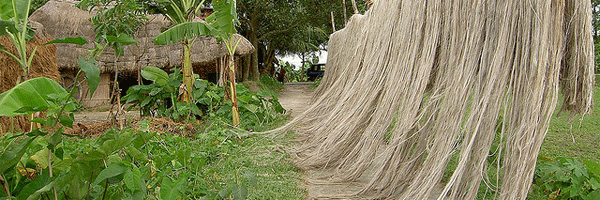
3.3.2 sisal
Sisal is a fiber harvested from agave cactus, at an average rate of 30-50 leaves per plant, per year, after maturing. An agave cactus is not mature until 2-5 years of age.19 Sisal is resilient to disease, able to be grown in most soil types (even typically considered poor soil), and has a large yield of fiber per pound.20 The fibers are removed, either by hand or with the aid of machinery, as soon as the leaves are cut from the plant, to avoid damage during the cleaning process due to drying prematurely.19 Many steps have been taken to avoid permanent damage in workers lungs, as studies have linked sisal production to lowered lung function.21
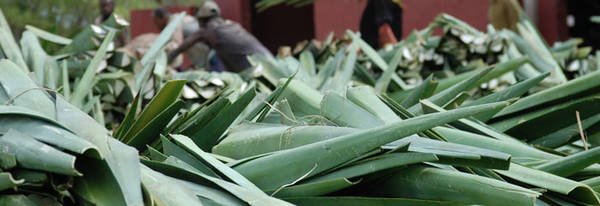
Harvested cactus leaves
- Artist Statement of Intent
My fascination with sculpture and my desire to pursue a career in art was initially instigated by witnessing the construction and display of large scale sculptures destined for Burning Man, while living in Reno. These pieces require a team of people cooperating toward a shared goal—a goal of sharing their art. Since being enrolled in sculpture classes at UNCA, I feel that I have finally found the materials and tools I am comfortable using. This has opened new avenues of independence in my art, but I will always acknowledge the roll others play in every step of its creation.
Luckily, one of my strengths is in collecting people to work towards a common goal, whether it be a group project, or all helping another on an individual project. I volunteer in background and leadership roles for several varied events and have experience in curating shows, parties, exhibits, and other social events. Outside of UNCA, I run a skill-share group, where we host arts, writing, psychology, defense, and other classes, as well as community building activities.
This artist, myself, will continue to operate with the words of a popular idiom, with no clear origin, constantly in the back of my mind—“Art doesn’t exist in a vacuum.” Unless an artist is collecting their own gum arabic, sawing down all their own trees, making nails, rope and glues, or tempering their own steel, there have been other people involved in the process. We are surrounded by nature and man-made inspiration every day. As artists, we must acknowledge that the creation is not entirely of ourselves.
References
- "Artists' Statements." Leonardo 31, no. 5 (1998): 475-79. doi:10.2307/1576612. www.jstor.org/stable/1576612.
- Dougherty, Patrick “Bio.” Patrick Dougherty. http://www.stickwork.net/about/.
- --“Recent Work” Patrick Dougherty. http://www.stickwork.net/work/.
- Tommey, Matt "Modern Rustic North Carolina Baskets." Matt Tommey. http://www.matttommey.com/.
- --“FAQs.” Matt Tommey. http://www.matttommey.com/faqs.html.
- --“Internships.” Matt Tommey. http://www.matttommey.com/internships.html.
- --"Kudzu Vine Harvester Wanted." Craigslist. https://asheville.craigslist.org/lbg/d/kudzu-vine-harvester-wanted/6396778194.html.
- --“In the Studio.” Matt Tommey. http://www.matttommey.com/in-the-studio.html.
- "Burning Man Arts." Burning Man. https://burningman.org/culture/burning-man-arts/.
- Chen, Katherine K. 2012. "Artistic prosumption: Cocreative destruction at burning man." American Behavioral Scientist 56, no. 4: 570-595. PsycINFO, EBSCOhost (accessed December 6, 2017).
- LadyBee. "The Outsider Art of Burning Man." Leonardo 36, no. 5 (2003): 343-48. http://www.jstor.org.proxy177.nclive.org/stable/1577497.
- Tommey, Matt. “How to Make Baskets.” Matt Tommey. http://www.matttommey.com/how-to-make-baskets.html.
- Marshall, Brain HowStuffWorks. "How Stuff Works: How Bamboo Works." Deseret News, Sep 28, 2010. http://0-search.proquest.com.wncln.wncln.org/docview/756907682?accountid=8388.
- "Drying Bamboo Poles." Guadua Bamboo. https://www.guaduabamboo.com/preservation/drying-bamboo-poles.
- "Dendrocalamus." Guadua Bamboo. https://www.guaduabamboo.com/genera/dendrocalamus.
- Weir, Ernest Elva. "How Rope Is Made." Scientific American 117, no. 1 (1917): 6-7. http://www.jstor.org.proxy177.nclive.org/stable/26121670.
- "A Bibliography of Cordage and Cordage Making.” The Cordage Institute. http://www.ropecord.com/new/dl/biblliography.PDF.
- © FAO. "Jute." Future Fibres: Jute. 2017. http://www.fao.org/economic/futurefibres/fibres/jute/en/.
- © FAO. "Sisal." Future Fibres: Sisal. 2017. http://www.fao.org/economic/futurefibres/fibres/sisal/en/.
- "SISAL." Journal of the Royal Society of Arts 65, no. 3383 (1917): 736-38. http://www.jstor.org.proxy177.nclive.org/stable/41347454.
- Baker, M. D., L. M. Irwing, J. R. Johnston, D. M. Turner, and B. N. Bezuidenhout. "Lung Function in Sisal Ropemakers." British Journal of Industrial Medicine 36, no. 3 (1979): 216-19. http://www.jstor.org.proxy177.nclive.org/stable/27723364.
Your art clearly takes after those people! If you can find any images, you should check out the temple form Tfus 2011 .
Thanks :) Inspiration comes from many places ;) I don’t even know where to start looking for temple pics, Don’t you have pictures of it?
I did. All my Effigy and Temple pics got deleted from the Tfus page though.
:(
Voyeurism is participation.
True inspiration.
My first work on steemit :D THX
https://steemit.com/art/@synner/what-is-an-artist
Thank you and Welcome!
This post has received a 63.36 % upvote from @boomerang thanks to: @puddles
I so very accidentally sent boomerang all of my sbd. I thought I had just put 3.33sbd, but it was 64.something. I about crapped my pants, ‘cause I don’t gamble...but, luckily it paid off.
Like, holy shit, I was scared.